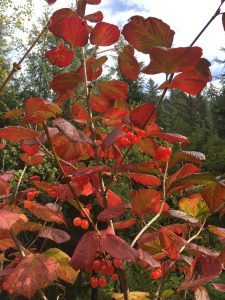Highbush Cranberries
“Highbush Cranberries” is a publication from the University of Alaska Fairbanks Cooperative Extension Service (CES), to which I have been referring on an annual basis for a couple of decades. The current version, revised in 2013, by Roxie Rodgers Dinstel (Extension Faculty) and Marci Johnson (Extension Program Assistant) is sitting in front of me as I blog. I have temporarily misplaced the berry-stained original that my mother handed down to me, but it will resurface, most likely stuck to another spot-on CES publication.
The Stench
Highbush cranberry is the common name for Viburnum edule, and is not actually a cranberry at all.
As kids, we would use dried cow parsnip (pushki) stalks to shoot the ripe berries at one another. This was a favorite pastime while waiting for the school bus on crisp, fall mornings. Oh, how that musky, sour smell permeated our new clothing!
Our mother would always make a batch of Spiced Highbush Cranberry Ketchup, following the recipe in the CES publication. She would painstakingly cook down the dreaded concoction to the proper consistency, which took hours. By the time it was finished, the entire house and everything in it was saturated with the stench of highbush cranberries.
Childhood memories of highbush cranberries were not exactly my fondest. Had I read about the extraordinary health benefits in the CES pub earlier in life, perhaps my opinion would’ve been different. Okay, doubtful.
The Aroma
Time passed and I noticed one sunny winter day that the highbush cranberries were still on the bushes, hanging on for dear life. How beautiful they looked against the pristine white snow. I snapped off a dried pushki stalk and tried the old “peashooter” but my technique was seriously rusty and I gave up with squashed berries all over me. Hmmm, the smell wasn’t that bad.
The next fall, I rifled through my mother’s recipe drawer to find the CES publication that contained the recipe for highbush cranberry ketchup, and off I went. The bushes were easy to distinguish with their brightly colored leaves. I’d never noticed their resemblance to maples!
While cooking down the berry concoction, I told my children what a healthy sauce was brewing, and not to worry, I would be free to make dinner in just a few hours. The house smelled deliciously of cinnamon, cloves and allspice. Really?
Wild and Wonderful
Now that we have accepted Viburnum edule into our diet, I have found ways to incorporate this beautiful shrub with ultra-healthy berries into the landscape. Rather than transplant them into a traditional garden, we design a garden around naturally occurring shrubs. Combined with other shrubs such as dogwood, lilacs and ninebarks, one can create a “berry” beautiful explosion of color and scent.
Thanks to the short, factual CES publication my eyes have been opened to the possibilities of embracing this shrub in all its beauty; the health benefits are a bonus. I’ll refer to it again next year, but first I’m going to try that freezer jam recipe!
